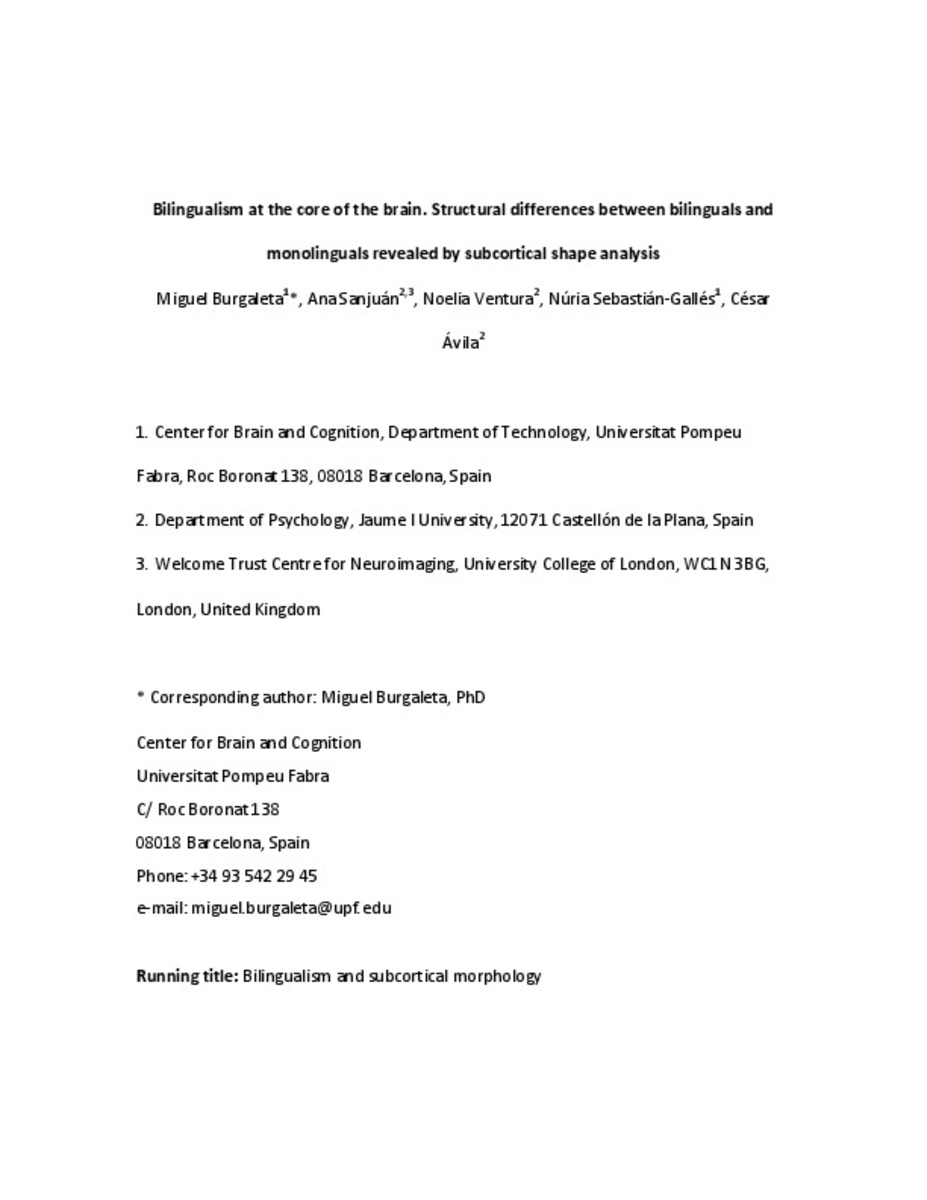Mostrar el registro sencillo del ítem
Bilingualism at the core of the brain. Structural differences between bilinguals and monolinguals revealed by subcortical shape analysis
| dc.contributor.author | Burgaleta, Miguel | |
| dc.contributor.author | Sanjuán Tomás, Ana | |
| dc.contributor.author | Ventura Campos, Mercedes | |
| dc.contributor.author | Sebastián Gallés, Nuria | |
| dc.contributor.author | Avila, Cesar | |
| dc.date.accessioned | 2016-06-01T09:49:35Z | |
| dc.date.available | 2016-06-01T09:49:35Z | |
| dc.date.issued | 2015 | |
| dc.identifier.citation | BURGALETA, Miguel, et al. Bilingualism at the core of the brain. Structural differences between bilinguals and monolinguals revealed by subcortical shape analysis. NeuroImage, 2016, vol. 125, p. 437-445. | ca_CA |
| dc.identifier.issn | 1053-8119 | |
| dc.identifier.uri | http://hdl.handle.net/10234/160175 | |
| dc.description | Naturally acquiring a language shapes the human brain through a long-lasting learning and practice process. This is supported by previous studies showing that managing more than one language from early childhood has an impact on brain structure and function. However, to what extent bilingual individuals present neuroanatomical peculiarities at the subcortical level with respect to monolinguals is yet not well understood, despite the key role of subcortical gray matter for a number of language functions, including monitoring of speech production and language control — two processes especially solicited by bilinguals. Here we addressed this issue by performing a subcortical surface-based analysis in a sample of monolinguals and simultaneous bilinguals (N = 88) that only differed in their language experience from birth. This analysis allowed us to study with great anatomical precision the potential differences in morphology of key subcortical structures, namely, the caudate, accumbens, putamen, globus pallidus and thalamus. Vertexwise analyses revealed significantly expanded subcortical structures for bilinguals compared to monolinguals, localized in bilateral putamen and thalamus, as well as in the left globus pallidus and right caudate nucleus. A topographical interpretation of our results suggests that a more complex phonological system in bilinguals may lead to a greater development of a subcortical brain network involved in monitoring articulatory processes. | ca_CA |
| dc.description.sponsorShip | This work was supported by grants from the Spanish Ministerio de Ciencia e Innovación (JCI-2009-04492, PSI2010-20168), the Spanish Ministerio de Economía y Competitividad (MINECO-PSI2012-34071), the European Community's Seventh Framework Programme (FP7/2007–2013) / ERC grant agreement n°323961, and Grup de Recerca en Neurociència Cognitiva (GRNC), AGAUR (2014 SGR 1210 N). M.B. was funded by the Spanish Ministerio de Economía y Competitividad (MINECO-FPDI-2013-17528). N.S.G. received the prize ICREA Academia for excellence in research, funded by the Generalitat de Catalunya. We thank Albert Costa for his comments on an earlier version of this manuscript. | ca_CA |
| dc.format.mimetype | application/pdf | ca_CA |
| dc.language.iso | eng | ca_CA |
| dc.publisher | Elsevier | ca_CA |
| dc.relation.isPartOf | NeuroImage, 2016, vol. 125 | ca_CA |
| dc.rights.uri | http://rightsstatements.org/vocab/CNE/1.0/ | * |
| dc.subject | basal ganglia | ca_CA |
| dc.subject | thalamus | ca_CA |
| dc.subject | structural MRI | ca_CA |
| dc.subject | neuroanatomy | ca_CA |
| dc.subject | bilingualism | ca_CA |
| dc.title | Bilingualism at the core of the brain. Structural differences between bilinguals and monolinguals revealed by subcortical shape analysis | ca_CA |
| dc.type | info:eu-repo/semantics/article | ca_CA |
| dc.identifier.doi | http://dx.doi.org/10.1016/j.neuroimage.2015.09.073 | |
| dc.rights.accessRights | info:eu-repo/semantics/openAccess | ca_CA |
| dc.relation.publisherVersion | http://www.sciencedirect.com/science/article/pii/S1053811915009763 | ca_CA |
Ficheros en el ítem
Este ítem aparece en la(s) siguiente(s) colección(ones)
-
PSB_Articles [1302]
Articles de publicacions periòdiques







